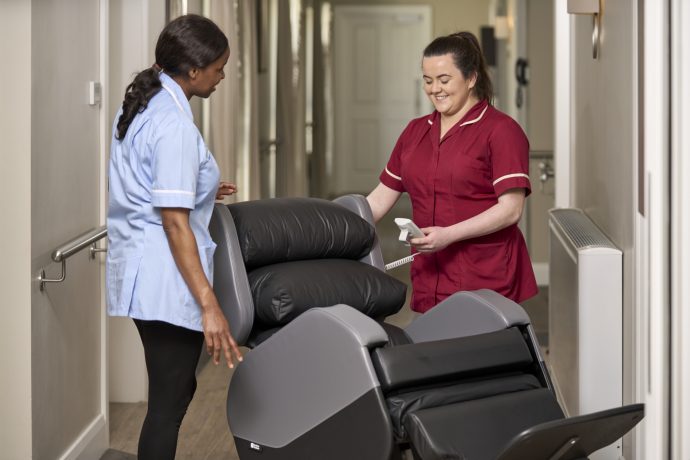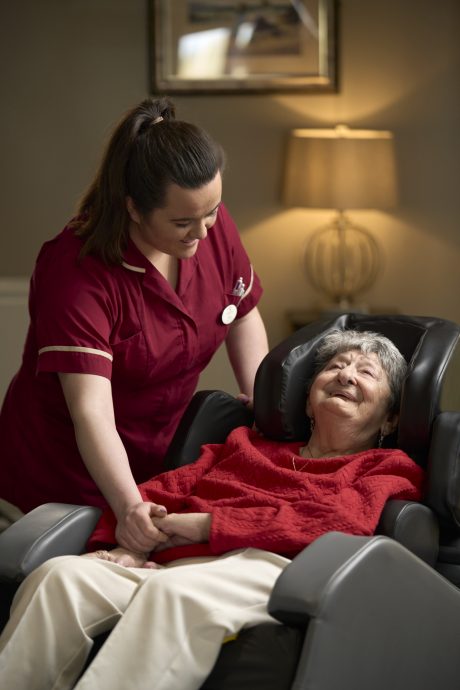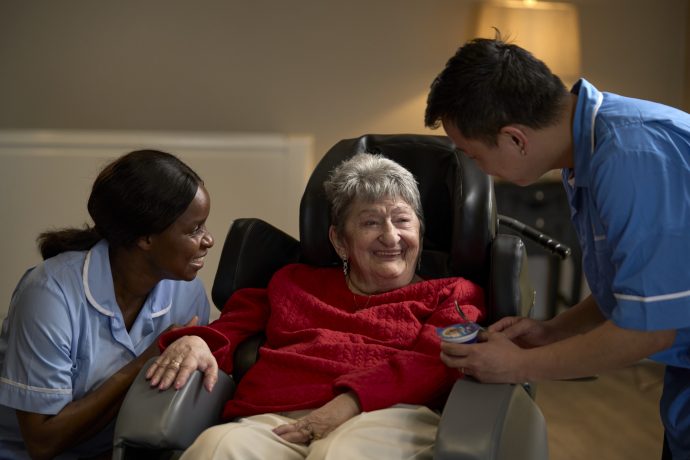
2nd September 2025
Empowering clinicians with expert-led training on clinical seating, pressure injury prevention, and best practice.
Learn More

Let our online product finder guide you through our simple steps to choose the chairs that best meet your patient’s needs.
Seating Solution FinderThe Envelo cushion provides excellent pressure redistribution and comes as standard on all Seating Matters chairs, meeting the clinical needs of most clients.
Explore Envelo RangeSeating Matters specialises in clinical, therapeutic seating solutions designed to improve patient care and safety, offering products for pressure injury prevention, postural support, and mobility assistance in healthcare settings.
Learn MoreDiscover how Seating Matters has transformed lives with our innovative seating solutions - read our inspiring customer success stories now!
Customer StoriesUsed in academia, in clinical practice and with caregivers around the world to guide their practices around specialist seating.
Download Free HandbookStop the Pressure Day is a poignant reminder of the importance of preventing pressure injuries and promoting overall well-being & quality of life.

Pressure injuries remain a common problem throughout the healthcare systems. Prevalence amongst inpatient in hospital is 3-14%, although it can be as high as 70% in elderly inpatients with orthopaedic problems.1
The experience of having a pressure injury can have a significant cognitive and psychological impact on the patient. The ability to do even minor tasks like reading, writing, eating, and drinking can be affected as well as decreased motivation, which may have an impact on the patient’s rate of recovery.
Pressure injuries cause pain, discomfort and reduced quality of life to patients and represent a monumental cost to health and social care systems.

We often take for granted the huge impact that pressure injuries have on patients. In order to fully realise this problem we must realise the seriousness of pressure injuries to the health and life of our patients.
Pressure ulceration in elderly patients is associated with a fivefold increase in mortality, and in-hospital mortaility this group is between 25% - 33%.1 One often overlooked aspect of this effort is the role that proper seating plays in maintaining skin health and preventing discomfort. In this blog post, we'll explore the significance of seating in the context of pressure care and why choosing the right seating solutions matters for individuals at risk.
It does not take a long period of time for a pressure injury to occur. Findings from studies done in the lying position indicate that pressure injuries under bony prominences very likely occur between the first hour and 4 to 6 hours after sustained loading. 2
With poor posture or the incorrect chair, the risk can be greater in sitting. This publication and the other publications from Seating Matters will assist you in the correct provision of clinical, therapeutic seating to manage pressure and posture. The Seating Matters chairs are specifically designed by our clinical team to help meet these needs.
In normal upright sitting, our weight is exerted as shown:
75% through the buttocks & thighs.
19% through the feet.
4% through the back.
2% through the arms. 3
Weight distribution through the Ischial Tuberosities (ITs) should be equal. Even then, 75% of body weight is supported on only 8% of our body area. 4
It is important to have the correct chair to provide pressure management and help to maintain good posture in sitting.
Posture and pressure injuries are inextricably linked. When a person sits in an abnormal posture, their weight may not be taken equally through the ITs. In a person with a pelvic obliquity for example, a greater percentage of their weight is channeled through the lower IT. This leads to higher interface pressure on this side, therefore increasing the possibility of a pressure injury occurring.
When carrying out a seating assessment, there are several key points which must be addressed to help manage pressure or reduce the risk of pressure injury development. When considering pressure management in seating, it is common to think only about the cushion on the chair. It is the most predominant element and often the first and only step used to address pressure management in seating.
To achieve effective pressure management in seating, The Four Principles of Effective, Clinical Seating™ should be incorporated.
These are;

When you increase an individual’s surface area contact with their chair, you reduce the pressure exerted through any point. It is imperative that the chair is measured and adjusted to the size and shape of the patient and adjusted to load their body properly. By maximising the amount of contact the patient can have with the chair through the feet, legs, femurs, arms and back, you are ensuring that pressure is being evenly distributed, thus reducing the amount of pressure through any given part of the body. For example, when loaded properly, the feet take 19% of the body's weight in seating.3 If there is no footplate on your chair, or the feet are incorrectly loaded, this 19% of weight will be going through the buttocks and thighs instead, therefore increasing weight, pressure and risk in this area.
Martina Tierney often says, “pressure and posture are inextricably linked” and it has been shown that better posture has a direct link to improved pressure management. For example, a person with a scoliosis and leaning to the left over their chair will have greater weight going through one side of their pelvis. Due to this unbalanced weight distribution, they will have an increased risk of skin breakdown under that side of their body.
Proper support on the left side will help to stabilise the patient in a midline posture and equalise the distribution of pressure through the body, rather than it being focused on a smaller area. To this end, the correct use of lateral and head supports will ensure improved posture, balanced loading and therefore reduced risk of pressure injury.
The International Guidelines recommend to reposition all individuals with or at risk of pressure injuries on an individualised schedule, unless contraindicated. 5 Repositioning can be accomplished by a change in the seated position, lifting the body off the weight bearing area or by standing. This can take a lot of energy, work and time, and in some cases, this leads to a patient not getting adequate or regular weight shifts.
Research shows that 45° tilt “maximises the potential for significant blood flow increases and pressure reduction” by allowing the patient to completely off-load their pelvis and allow re-oxygenation of the tissue. 29 With caregiver or user-operated 45° tilt in a chair, it is much easier to reposition the patient periodically and thus facilitate effective weight shifts. If 450 of tilt is not appropriate or suitable for a patient based on an assessment, 30° of tilt will also give a degree of repositioning.
There are ranges of cushions on the market to provide different levels of support, postural alignment and for pressure management. In seating, it is important to be able to select different cushions to meet the individual needs of that person.
As standard, all Seating Matters chairs come with a visco-memory foam cushion. It is made up of two layers of foam – the top layer allowing immersion and envelopment of bony prominences like the pelvis, and the bottom layer giving a stable base of support. This cushion performs very well for many patients but in many cases, a secondary cushion is prescribed by a wound care clinician. In these cases, it is important that your chair can have a removeable cushion and a solid base board to hold the new cushion in place.
Cushion coverings should be made from multi-directional stretch fabrics to prevent hammocking. These fabrics should be breathable to prevent excessive moisture on the skin.
1. Grey, J.E., Harding, K.G., Enoch, S. (2006). Pressure ulcers. BMJ 2006;332:472.
2. Gefen, A. (Oct 2008). How much time does it take to get a pressure ulcer? Integrated evidence from human, animal, and in vitro studies. Ostomy Wound Management, 54(10), 26-35.
3. Staas, W.E., Cioschi, H.M. (1991). Pressure sores: a multifaceted approach to prevention and treatment. Western Journal of Medicine, 154, 539-544.
4. Trumble, H.C. (1930). The skin tolerance for pressure and pressure sores. Medical Journal of Australia; 2: 724-726.
5. European Pressure Ulcer Advisory Panel, National Pressure Injury Advisory Panel and Pan Pacific Pressure Injury Alliance (2019). Prevention and Treatment of Pressure Ulcers/Injuries: Quick Reference Guide. Emily Haesler (Ed.). https://guidelinesales.com/pag...
This excerpt has been taken from the latest edition of The Clinician's Seating Handbook, a reference guide for clinical seating provision by Martina Tierney.
You can download your copy here: https://seatingmatters.com/gb-...
Take the next step to achieve clinical excellence and a 24 hour package of care for patients.

Arrange a free, no obligation assessment of clinical, therapeutic seating.

Schedule a call at a time that suits you to speak with our experts.

Download your copy of The Clinician's Seating Handbook

2nd September 2025

15th August 2025

15th August 2025